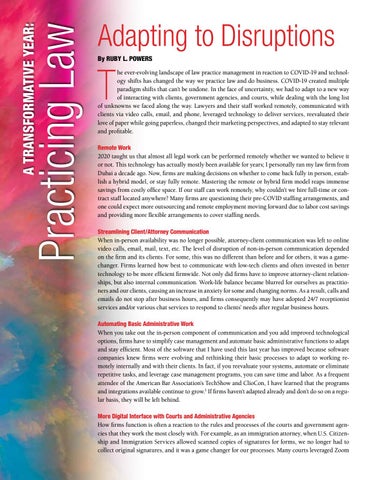Practicing Law
A Transformative Year:
Adapting to Disruptions
T
By Ruby L. Powers he ever-evolving landscape of law practice management in reaction to COVID-19 and technology shifts has changed the way we practice law and do business. COVID-19 created multiple paradigm shifts that can’t be undone. In the face of uncertainty, we had to adapt to a new way of interacting with clients, government agencies, and courts, while dealing with the long list of unknowns we faced along the way. Lawyers and their staff worked remotely, communicated with clients via video calls, email, and phone, leveraged technology to deliver services, reevaluated their love of paper while going paperless, changed their marketing perspectives, and adapted to stay relevant and profitable.
Remote Work 2020 taught us that almost all legal work can be performed remotely whether we wanted to believe it or not. This technology has actually mostly been available for years; I personally ran my law firm from Dubai a decade ago. Now, firms are making decisions on whether to come back fully in person, establish a hybrid model, or stay fully remote. Mastering the remote or hybrid firm model reaps immense savings from costly office space. If our staff can work remotely, why couldn’t we hire full-time or contract staff located anywhere? Many firms are questioning their pre-COVID staffing arrangements, and one could expect more outsourcing and remote employment moving forward due to labor cost savings and providing more flexible arrangements to cover staffing needs. Streamlining Client/Attorney Communication When in-person availability was no longer possible, attorney-client communication was left to online video calls, email, mail, text, etc. The level of disruption of non-in-person communication depended on the firm and its clients. For some, this was no different than before and for others, it was a gamechanger. Firms learned how best to communicate with low-tech clients and often invested in better technology to be more efficient firmwide. Not only did firms have to improve attorney-client relationships, but also internal communication. Work-life balance became blurred for ourselves as practitioners and our clients, causing an increase in anxiety for some and changing norms. As a result, calls and emails do not stop after business hours, and firms consequently may have adopted 24/7 receptionist services and/or various chat services to respond to clients’ needs after regular business hours. Automating Basic Administrative Work When you take out the in-person component of communication and you add improved technological options, firms have to simplify case management and automate basic administrative functions to adapt and stay efficient. Most of the software that I have used this last year has improved because software companies knew firms were evolving and rethinking their basic processes to adapt to working remotely internally and with their clients. In fact, if you reevaluate your systems, automate or eliminate repetitive tasks, and leverage case management programs, you can save time and labor. As a frequent attendee of the American Bar Association’s TechShow and ClioCon, I have learned that the programs and integrations available continue to grow.1 If firms haven’t adapted already and don’t do so on a regular basis, they will be left behind. More Digital Interface with Courts and Administrative Agencies How firms function is often a reaction to the rules and processes of the courts and government agencies that they work the most closely with. For example, as an immigration attorney, when U.S. Citizenship and Immigration Services allowed scanned copies of signatures for forms, we no longer had to collect original signatures, and it was a game changer for our processes. Many courts leveraged Zoom
